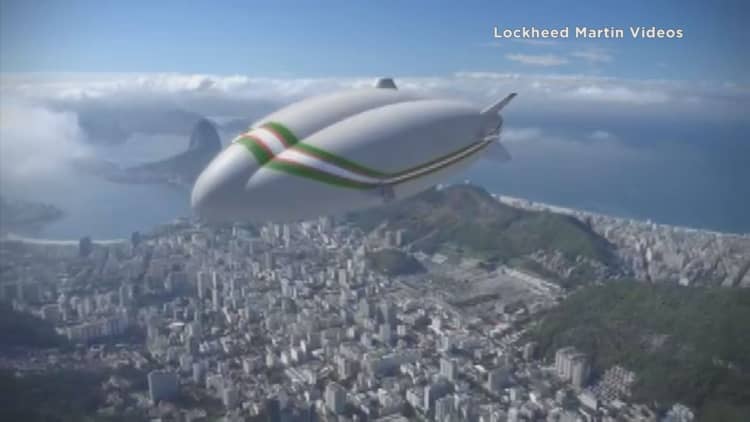
Lockheed Martin has landed its first contract for the hybrid airship it created inside its top secret Skunk Works division. In a deal valued at $480 million, Straightline Aviation (SLA) has signed a letter of intent to purchase 12 of the heavier-than-air airships that measure nearly a football field long. First delivery is scheduled for 2018, with the final airship expected no later than 2021.
The helium-filled airships will be able to carry 20 tons of cargo to remote places without roads. They will even be able to hover over open water. Lockheed has been pitching the airships as a cheaper, more environmentally friendly way to deliver supplies and equipment.
"There is a real need for this," said SLA CEO Mike Kendrick. "It can cost up to $1 billion to put all the infrastructure in for an oil well." He said falling commodity prices have not hurt interest in the airships — quite the opposite, given the cost savings — and U.K.-based SLA has four or five customers ready to try out the airships whenever they're finally ready.
Kendrick used to run Richard Branson's Virgin Airship and Balloon Company, which had 19 blimps around the globe used for advertising or camera work. He was also flight director for Branson's balloon flights. He and his team formed Straightline to focus initially on delivering cargo.
What attracted SLA to the Lockheed Martin product is that the hybrid airship is heavier than air, even though it is filled with helium. Its skin and airframe weigh it down, it doesn't need mooring like a traditional blimp. Engines guide the airship into position, and on its belly are wheel-like structures that spin to let it either hover or "grip" a surface. Lockheed said this provides stability in windy conditions for loading and unloading supplies, making it much easier to operate than a lighter-than-air machine.
"The difference between lighter-than-air and hybrid airships is quite profound," said SLA's CEO. "It may seem small but it is a spectacular development."
Lockheed proved the concept a decade ago with a one-third size prototype, and it has spent years figuring out the right size and the right markets, spending more than $100 million on the project. This is also the first time that Skunk Works, a division of Lockheed Martin more famous for creating legendary military aircraft like the SR-71 and Stealth fighter, has developed something for the commercial market. The company even created a special sales and marketing arm, called Hybrid Enterprises.
There are competitors, most notably the Airlander 10 being built by U.K.-based Hybrid Air Vehicles. The Airlander was unveiled last week and labeled the world's largest aircraft, a lighter-than-air hybrid that may focus more on the tourism market.
Straightline COO Mark Dory said his company has also been talking to HAV about a potential deal in the future and is "very hopeful" the Airlander will be a success. However, he added, "at the moment, our focus is in cargo rather than the the passenger side."
But the passenger side is on the horizon, along with other potential markets in disaster relief, communications, agriculture and renewable energy.
SLA's Kendrick said oil, gas and mining are the "low hanging fruit," to start with, whether it's delivering cargo by air to the "soft sands" of the Middle East, or removing the need to build annual ice roads in northern Canada. "Some ice roads can cost $20 million a year to construct," said Rob Binns, CEO of Lockheed Martin's Hybrid Enterprises. That is one market SLA hopes to target. "You don't have to build ice roads ... and wait for the environmentalists to give you permission," said CEO Kendrick. "You can just land on ice."
Correction: This story was updated to correct the name to Hybrid Air Vehicles.



